학습환경의 정의
긍정적 학습 환경이 학생들에게 미치는 영향
긍정적 학습 환경 조성하기
결론
참고문헌
• 학습환경은 인간에게 상당히 많은 영향을 미침
• 학습환경에 따라서 교육의 결과는 달라짐
• 학습자가 학습환경에 상당히 영향을 받으며
이를 통해 학습경험을 형성하기 때문 (김지혜, 2009)
• 학습환경과 경험에 의해 자아개념이 형성됨
김아영(2010). 자기결정성이론과 현장 적용 연구. 교육심리연구, 24(3), 583-609.
김주환, 김은주, 홍세희 (2006). 한국 남녀 중학생 집단에서 자기결정성이 학업성취도에 주는 영향. 교육심리연
구, 20(1), 243- 264.
김지혜(2009). 미술교육환경과 미술교과의 자기효능감, 성취동기, 학습흥미간의 상관분석에 관한 연구 : 4-6학
년 서울지역을 중심으로, 성신여자대학교 석사학위 논문.
문은식(2002). 고등학생이 지각한 학교의 심리적 환경과 목표지향성의 관계. 교육심리연구, 16(4), 5-21.
방희정(2005). 미술과의 심리적 교육환경이 자기효능감과 흥미도에 미치는 영향 : 초등학교 3-6학년을 중심으
로, 이화여자대학교 석사학위 논문.
안도희, 박귀화, 정재우(2008). 자율성 지지, 기본적 욕구 및 심리적 안녕감 간의 관계. 청소년학연구, 15(5),
315-338.
이명희(2008). 자기결정성이론에 근거한 한국형 기본 심리 욕구 척도 개발 및 타당화. 이화여자대학교 석사학
위 논문.
이민희(2007). 학습장면에서 자기결정론의 동기화 경로 모형검증. 중앙대학교 박사학위 논문.
장상호(1997). 교육의 재개념화에 따른 10가지 새로운 탐구영역. 교육원리연구, 2, 111-212.
정교영(2011). 자기결정이론을 근거로 한 부모교육 프로그램 개발 및 효과검증. 아주대학교 박사학위 논문.
정원식 외 2인 공저.(1994). 교육심리학. 서울:교육출판사. 125.
정원식(1975). 교육환경론. 서울:서울출판사. 33-37. 주동식(2009), 학생․교사의 목표지향과 자기효능감 및 학
업성취와의 관계, 전북대학교 박사학위 논문.
주동식(2009). 학생 · 교사의 목표지향과 자기효능감 및 학업성취의 관계. 전북대학교 박사학위논문.
최병연(2002). 자기결정성 학습동기 이론의 교육적 적용. 교육문제연구, 16, 165-184.
한소영(2010). 내담자의 기본 심리적 욕구 만족과 상담성과: 자기결정이론의 치료적 적용, 아주대학교 박사학
위 논문.
Ames, C. (1992). Classrooms: Goals, Structures, and Student motivation. J. Educ. Psychol, 261-271.
Ames, C. & Archer, J. (1988). Achievement goals in the classroom: Students' learning strategies and motivat
ion process. Journal of Educational Psychology, 80, 260-267.
Anderman, E. M., Maehr, M. L., & Midgley, C. (1999). Declining motivation after the transition to middle sc
hool: Schools can make a difference. J. Res. Dev. Educ, 1–14.
Anderman, E. M., & Midgley, C. (2002). Methods for studying goals, goal structures, and patterns of adapti
ve learning. In C. Midgley & Mahwah (Ed.), Goals, Goal Structures, and Patterns of Adaptive Learning(pp. 1-53). NJ: Erlbaum.
Bhurijana, D. (1995). The Art of Teaching: A guide for training our children in Krsna consciousness, Vrindav
ana Institute for Higher education. 77.
Deci, E. L., & Ryan, R. M. (2000). The "what" and "why" of goal pursuits: Human needs and the self-determi
nation of behavior. Psychological Inquiry, 11, 227-268.
Deci, E. L., & Ryan, R. M. (2002). Handbook of self-determination research. NY: University of Rochester Pres
s.
Dweck, C. S. & Leggett, E. L. (1988). A social-cognitive approach to motivation and personality. Psycholog
ical Review, 95, 256-273.
Haggis, D. (2011). Teacher Perceptions of What they do in their institutionalized settings to create a positiv
e learning environment for troubled youth in their classrooms, College of education, Nursing, and Health Professions at the University of Hartford, West Hartford.
Kaplan, A., Gheen, M., & Midgley, C. (2002a). Classroom goal structure and student disruptive behavior. B
r. J. Educ. Psychol. 191–212.
Kaplan, A. et al. (2002b). Achievement goals and goal structures. In Goals, Goal Structures, and Patterns of
Adaptive Learning, ed. C. Midgley, 21-55. Hillsdale, NJ: Erlbaum.
John, M. B., Timothy, C. C. (2005). Using student norms to create positive learning environments, About Ca
mpus, 9(6), 2-7.
Joye, F., Deschryver, N., & Peraya, D. (2002). Learn-Nett: A collaborative environment for teacher training. In
F. Fluckiger, C. Jutz, P. Scholtz & L. Cantoni (Ed.), Proceedings of the 4th International Conference on New Educational Environments (poster 12).
Judith, L. M., Eric, M. A., & Lynley, H. A. (2006). Classroom Goal structure, student, motivation, and academi
c achievement, Annu. Rev. Psychol, 487-503.
Keith, J. T. (2005). Trends in Peer Learning, Educational Psychology Vol 25. No. 6, December 2005, Universit
y of Dundee, Scotland, 631-645.
Lizzio, A., Wilson, K. & Simons, R. (2002). University students' perceptions of the learning environment and
academic outcomes : implications for theory and practice, Studies in Higher Education, 27, 27-52.
Mark, G. (2011). Characteristics of Learners with mastery goal versus performance goal. Western oregon u
niversity, Monmouth OR, 15.
Midgley, C. (2002). Goals, Goal Structures, and Patterns of Adaptive Learning. Hillsdale, N J: Erlbaum.
Midgley, C., Maehr, M. (1999). Using motivation theory to guide school reform. In Promoting Positive Outc
omes: Issues in Children’s and Families’ Lives, ed. A. J. Reynolds, H. J. Walberg, R. P. Weissberg, 129–159. Washington, DC: Child Welfare League Am.
Midgley et al. (1997). Patterns of Adaptive Learning Survey (PALS). AnnArbor: Univ. Mich. Press.
Niemiec, C., Ryan, R. M. (2009). Autonomy, competence, and relatedness in the classroom: Applying self-de
termination theory to educational practice. Theory and Research in Education, 7(2), 133–144.
Pintrich, P. R. & Schunk, D. H. (2002). Motivation in education: Theory, research, and applications(2nd ed.).
Upper Sadde River, NJ: Merrill/PrenticeHal.
Ryan, R. M., & Deci, E. L.(2000). Self-determination theory and the facilitation of intrinsic motivation, social
development, and well-being. American Psychologist, 55, 68-78.
Ryan, R. M. (1993). Agenc




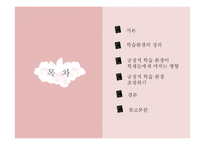
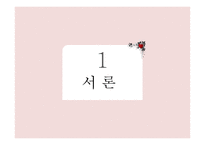
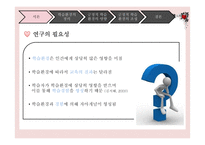

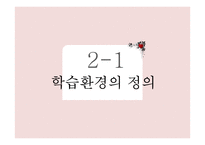
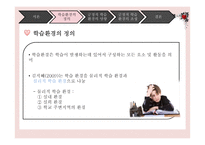
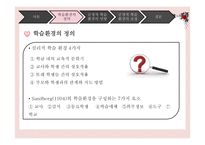

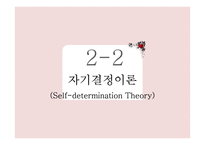
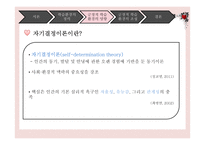

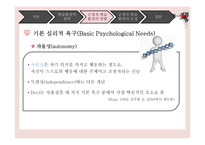

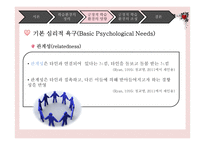
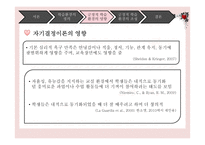
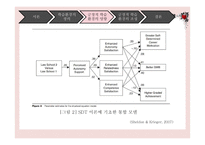
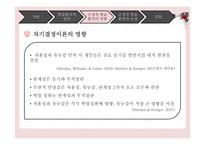
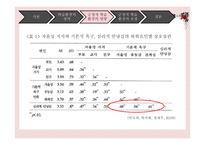
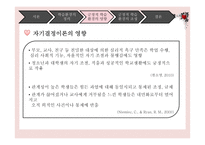
 분야
분야


